Moving Lights (or just “movers” in the industry) sure are fun. No concert, dance, tradeshow, musical,or Event is complete without a bunch of them moving around, and some are even used well (though, less and less, I notice – I get more grumpy about this as I get older!).
They came into mainstream being in the early 80’s, were popularised from the early 90’s, and came down in price over the next 10 years, so now,
they are so cheap your local pub probably has a few over the dance-floor, and you can buy a basic one for US$400 or so(though, those are not the ones used for a touring show).
One enormous, reputable vendor of moving lights in the 90’s (and still now… kinda) was vari*lite, the band Genesis funded moving lights development through vari*lite for their Abacab tour in ’81.
Moving lights fall into two main categories: moving head, and moving mirror
[1]. A moving head light looks like this:
The egg-shaped thing moves around (up and down, left and right) with a very fine resoloution, so the beam from the front of the light can be placed pretty much anywhere, except behind the chassis (in this image, directly up). The egg-shaped thing contains the lamp, and many motors that control how the beam looks – more details below.
Moving mirror lights looks like this:
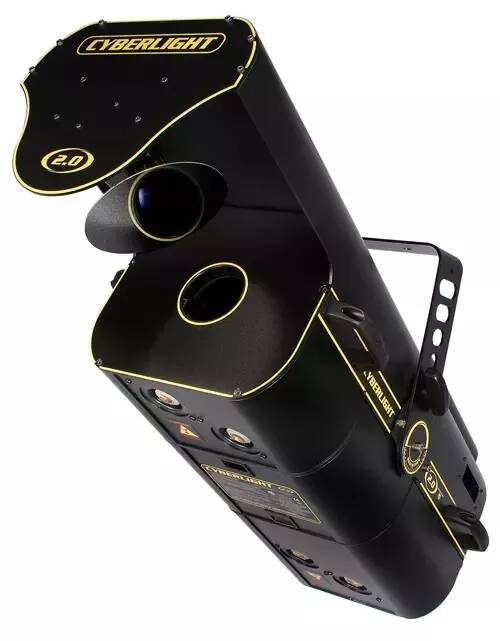
The moving mirror lights work from being mostly static, where the light beam is focussed, has colour and patterns applied, and shoots out the front lens, onto a mirror, which moves on two axis (up-down and left-right), but only around 135 degrees on each axis. The mirror moves incredibly fast, but it cannot shine in many places, as you can guess form the image above. For many purposes, this is not a problem, and the apparatus can be hung in any position, and the mirror head assembly can be rotated to suit the show (then locked off for the duration of the show).
Why so different? Well a few reasons, and biggest one is cost: moving mirror lights are cheaper to manufacture (smaller motors, and less moving parts, as we shall see). Also, it seems, vari*lite had some patents on some big areas of moving lights, that stopped others from developing them, but that’s no longer the case (I am not sure of the details).
Moving lights are used extensively in the entertainment industry, which by its nature is transient: many shows are set up in a venue for a few days (or just one night), then packed down and moved out to the next venue, sometimes every three days for years on end (eg, U2, etc). Some moving lights stay in a venue permanently, ready to be programmed for whatever show is in that venue. Others stay in a venue for months (or even years), for the duration of that show (for example, a musical theatre show on Broadway). Others are hire stock, and the hire company wants to get those expensive things out on shows as much as possible.
All this means, moving lights need to be tough to withstand touring, and modular, so they can be repaired in the field, without being totally replaced. As is true in any business, the more robust and modular a Thing is, the more it costs… but the longer it lasts.
Moving head lights hugely dominate the scene now, compared to moving mirror fixtures, probably by a ratio of 9:1, so I’ll spend my time on moving head lights, with which I have the most experience. I was a lighting technician on events for 10 years or so, in my 20’s (1993 to 2003). I did some touring around Australia and some based in various cities working from lighting hire shops, preparing equipment and working on shows. I have not worked in lighting for 10 years now, but I keep up with the developments, and there have not been many significant changes in the last 15 years or so, apart from LED technology (more in a moment).
Moving head lights can be split into two further categories: profiles and wash lights. The image above is of a profile style. These are used to project patterns, that can be sharply in focus (or not, as the lighting designer chooses). Wash lights have a broader beam, to provide a “wash” of colour across the stage, with soft edges.
A Wash light looks like this:

Below, here’s a pic from a show with a mixture of wash and profile lights (most shows will have a mixture of both).
The white beams are from profiles, and the blue from wash lights:
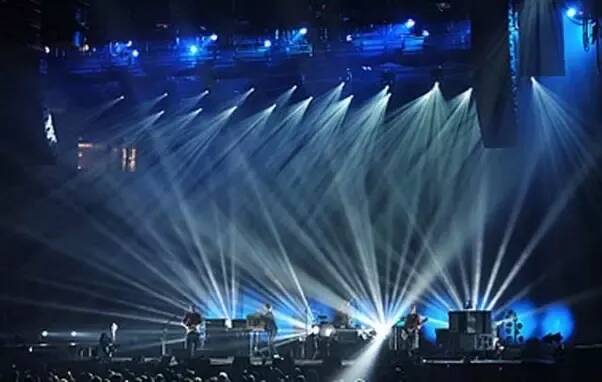
The white beams have been split into around a dozen smaller beams using a “gobo”, making it look like there’s a lot more moving lights than there really is – we’ll talk about gobos shortly.
Moving lights are controlled by specialised computer software (usually built into specific hardware devices), and are organised in a building block fashion, so key to answering this question is to understand how any one fixture works internally, then scaling this idea up over many fixtures, via a control system.
Moving head Profiles and Wash fixtures have a lot in common (called the beam path, from the light source, to the front lens), so I’ll go through both together, and note what elements are profile-only. The specific order of elements in the beam path changes depending on many variables, so I’ll list these in one possible order.
Moving lights weigh between 30 and 50Kg (66 to 110 lbs), and are roughly 400x500x700 mm (16x20x30 inches), throw around 1500 to 2000 BTU/hr, and draw around 16 amps at 120v… but there is a huge variety. The cost from US$400 to US$20,000, with an average being around US$8000 for a typical high performance touring fixture.
The following elements are located in the “egg”:
Light source
The light source in a moving light may be a HMI (Hydrargyrum medium-arc iodide – “Hydrargyrum” is Latin for Mercury), where, as Wikipedia says, the lamp operates by creating an electrical arc between two electrodes within the bulb that excites the pressurized mercury vapour and metal halides, and provides very high light output with greater efficacy than incandescent lighting units. If not a HMI, lamps are HID (high intensity discharge) of some sort, an arc lamp (as opposed to a lamp with a filament, “incandescent”, as you may have at home). Arc lamps are very efficient (lots of light output, for their energy consumption), expensive (US$500 to US$900 per, for ~2000 hours of use), and fragile.
Way – and I mean WAY – more efficient, are LED’s, and the entire lighting industry is being taken over by LED fixtures, which are shockingly good, and getting better. Their application for profile-based moving lights is limited currently, as the beam path means the light must go through many filters and lenses which each reduce the intensity of the light, so we need to start with a very bright source to begin with. However, LED’s and associated electronics are getting more sophisticated, and we’ll see more and more of them coming on the market. LED wash lights on the market are quite effective in smaller environments (eg, venues up to 1000 people).
Here’s a LED wash light. Each hole has one really bright LED in it (actually, probably a tri-colour LED):
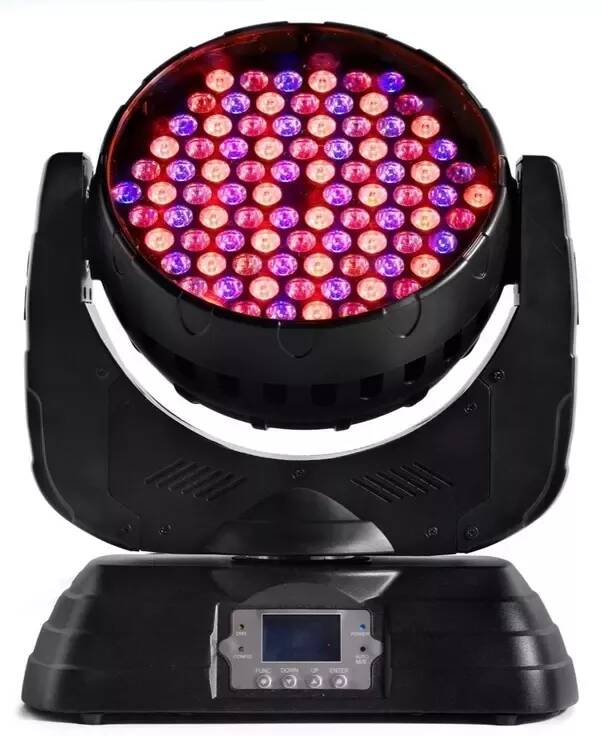
Some specialised moving lights (VL5’s, one of my faves) use incandescent lamps, but that is very out of fashion now.
Behind the lamp is a reflector, that sends as much light as possible in one direction, and an aperture of around 50 to 75mm (2 to 3 in.) diameter, which is the start of our beam path.
Intensity
HID and HMI lamps generally cannot be dimmed (that is, made less bright), they only have two states, on and off, so a mechanical dimmer is necessary. There are a variety of mechanical operations, but all work on a similar principle. Because the beam is not focussed (because it has not passed through any lenses yet), any obstruction between the beam and the end of the beam path will cast a shadow that has very fuzzy edges – so fuzzy that effectively, all that happens is that less light comes out, from 100% (nothing in the beam path) to 0% (the beam path is fully blocked).
A small thin metal sheet, perhaps with some sort of regular pattern of holes in it is used to dim the beam. More holes lets through more light, less holes lets less light through. The precise position of this mechanical “shutter” is controlled by a micro-stepping motor – the thin sheet of metal is mounted on the shaft, and can be adjusted in very small increments – a quarter of a degree, for example – giving extremely precise control of the intensity (usually measured in %, from 0 to 100).
Below, here’s an exploded diagram of one type of mechanical shutter assembly. The two “lawn mower” blades marked (4) are the thin sheets of metal that rotate in and out of the beam path (represented by the large circle). The stepper motors that control the blades are marked (7) (the x2 means there are two stepper motors, one for each blade).

Moving light light sources get incredibly hot (LED’s are the exception, which always run much cooler), and blocking the beam path so close to the light source generates intense heat, so Special materials are used here.
All that being said, in many environments, moving lights tend to be operated at full intensity most of the time (that is, nothing in the beam path deliberately dimming the light), but some exceptions would be in “fine arts” applications – drama, dance, opera, etc, where more subtle lighting is appropriate.
Strobe
This same mechanical dimmer can move (rotate) extremely fast, from fully closed to fully open, many times per second, giving moving lights a built in strobe effect that’s remarkable; when a few hundred movers are strobing in synch, it’s an amazing look. This effect does not work well on TV for some technical reasons, so the effect alone is seldom seen in that medium, but often used in live performances.
Colour
Colour is subtractively taken out, via possible several methods, but a common method is graduated colour flags of cyan, yellow and magenta, giving an effectively infinite range of colours (and who’s to say where one colour ends and another begins?).
Colours can be smoothly cross-faded over any time-frame (say over 10 minutes from a dark blue, through red, orange, yellow, to white, to simulate a sunrise), or pretty much instant if preferred – or anywhere in between.
In the below image, a series of flags (two each for C, Y, M, and “dim”, for “dimmer”, as discussed above in Intensity). The flags rotate in and out, again on the shafts of stepper motors, very accurately.
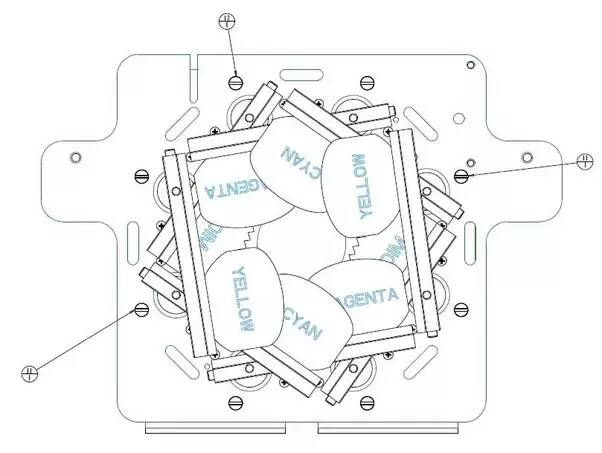
In the below images, an isometric rendering of the same assembly from front and back, you can see each of the eight flags have their own stepper motor. Each flag’s curved end starts as clear, and gradually gets more saturated in its colour of cyan, yellow or magenta, as it moves in over the beam path.
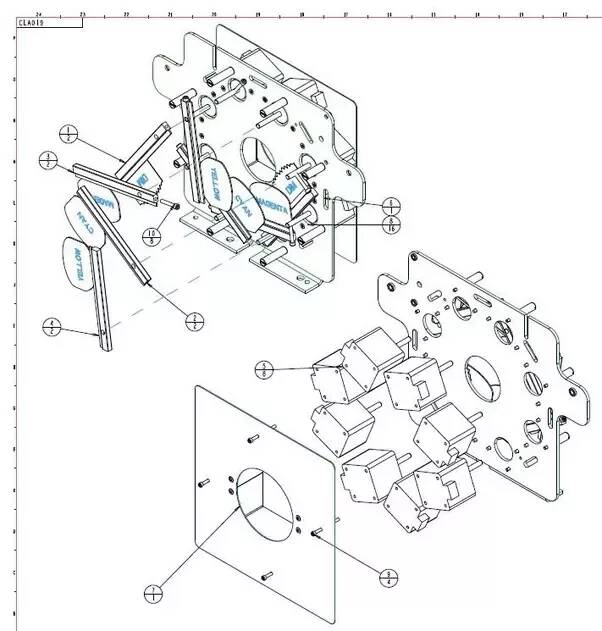
Because subtractive colour mixing is not perfect, the result is often poorly saturated reds and purples, so many moving lights also have a colour wheel, with special dedicated colours that can be selected (as well as “open white” – no colour). These wheels work the same as the pattern wheels, below, and are either “in” the beam path, or “out” of it (eg, “Have you got the red in that?”).
Patterns (profile only)
In lighting parlance, a patterned beam is created from a gobo (“go between”), a thin piece of metal with a shape cut in it, placed in the beam path, producing a silhouette of the shape. Another common gobo technique is for it to be etched or painted on a disc of glass, which can be a range of colours.
Basic gobos (for a static, not moving) light looks like this:
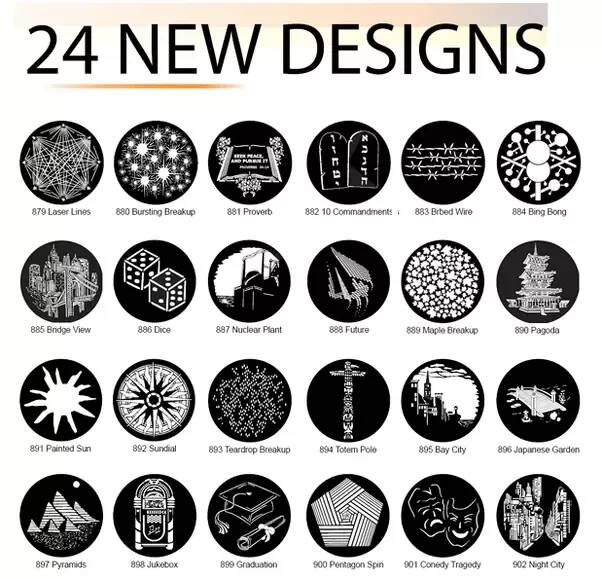
There are literally thousands of designs available. These are 3 to 5 inches in diameter. Moving light gobos are smaller, at 1 to 2 inches, and fit onto a wheel of 8 or so, like this (these are glass gobos):
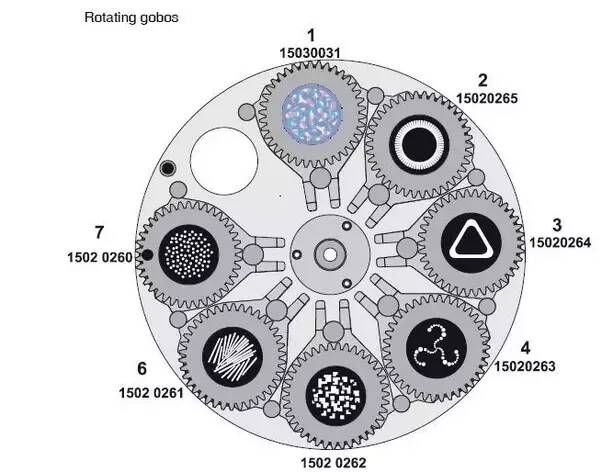
Notice how each gobo has gear teeth around it – that’s so when selected, they can be set to rotate at a range of speeds. Most moving lights will have two gobo wheels, one for rotating gobos, and one for static (or, non-rotating) gobos. One gobo wheel might be set to “open” – no gobo in the beam path – while the other is set to one of the 8 on the wheel.
But this two-gobo-wheel mechanism means gobos can be overlaid (that is, both placed in the beam path), to create interesting effects (because they are in different places in the beam path, an adjustment of the focal lenses can result in a cross-fade in patterns, a neat trick… but because both gobos are in the beam path, intensity is noticeably reduced however).
Effects wheel (profile only)
The effects wheel is another wheel that some profile movers have, much like the gobo wheels, where other things can be placed – more gobos, special colours, or “effects”. One example effect is “frost”, which fuzzes the edges of the beam in a specific and predictable way. Another is a prism, that splits the beam into many versions of the same thing (mostly out of favour these days).
Zoom and focus
Moving lights will have a bunch of lenses (up to six) to zoom (control the size) and focus (control the edge definition) of the light beam. More advanced fixtures will have broader zoom ranges. The “frost” in the effects wheel can make the beam in and out of focus (fuzzy edges) very quickly (especially, if the “frost” slot is right beside the “open” slot), the zoom and focus mechanisms are slow (a worm drive, usually), which is very precise and has lots of torque, but sacrifices speed.
Pan and tilt
Two sets of stepper motors actuate the yoke (technically, one set may be mounted in the “egg”), usually via a gearing system and toothed drive belts. As all stepper motors, these are incredibly accurate (for example, a fixture throwing a beam on to an area 20 metres (60 feet) away can be moved an inch either way to precisely line up with a performer or set piece.
Moving head lights can rotate around 500 degrees, and tilt around 290 degrees, giving plenty of coverage of the stage.
Moving lights can be mounted hanging above the stage nominally pointing down, side-of-stage mounted on a vertical truss, or floor mounted, nominally pointing up. In the control system, the axis’ can be inverted so this makes sense when controlling the devices. Movers are sometimes placed on diagonal trusses, or moving trusses as well – they can be placed in any position, so long as they get their two inputs…
Inputs
Moving lights require two inputs: power (regular power, usually auto-sensing 100 to 230v), and data. Data is usually the industry standard DMX-512 (actually RS-485, serial via two twisted pairs), using 5-pin XLR connectors (kind of like a mic plug, but with five pins), like this:
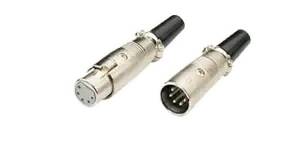
Addressing
Each fixture needs to be “addressed”, so it knows what to “listen” to in the data stream that DMX512 carries. DMX-512 controls 512 channels of information that may be from 0 to 100 (nominally represented in some control systems as %, but actually 0 to 255).
Moving lights “take up” n channels – the more basic fixtures will take up 5 to 15 channels. More advanced fixtures might be 40 to 60 channels. For a 60-channel fixture, fixture 1 would be addressed as 001, fixture 2 addressed as 061, and so on.
DMX-512 was originally designed for controlling static lights, such as you might see in a theatre or old concert, and 512 is more than any but the most enormous shows could need of “conventional” fixtures. But, it’s only 10 51-channel fixtures, and larger shows will have dozens or even hundreds of moving lights on them (the musical theatre shows I worked on had 30 to 60), plus 350 conventional fixtures – that’s pretty average for musical theatre.
So, it’s common to have several – or even dozens – of “universes” of DMX-512 running for any one show. Most lighting desks (discussed below) will have several 2 to 8) universes of DMX-512 outputs, and system techs might set one universe for the conventional lights, another universe for one brand of fixtures, or all the floor fixtures, or all the fixtures towards the front of the stage, or some other division that helps with testing, troubleshooting and maintenance.
Addressing is done via a small control screen on the fixture itself (the same screen also allows techs to access diagnostics, and test functions), and some are touch screen these days (in the old days, it used to be a block of 8 DIP switches, for 1, 2, 4, 8, 16, 32, 64, 128, and you’d switch them on and off to make any address from 1 to 512. Plenty of room for error!).
Here’s part of an addressing chart (for a 30-channel Cyberlight, actually an old-school moving mirror device) – this is for ONE of the 30 channels, channel 7, which controls the colour/gobo wheel (a lighting designer might specify some additional special colours to be placed in the gobo wheel for some reason, and the device does not really care what’s in there):
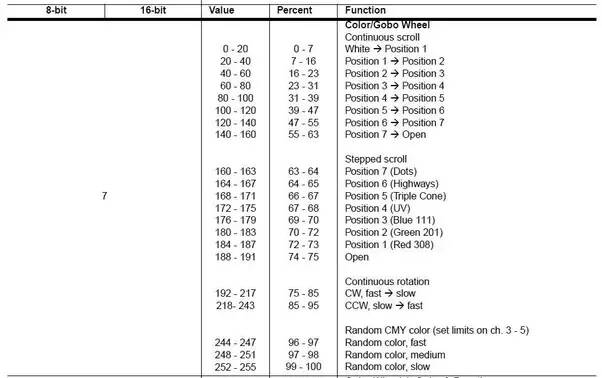
So, if on the control system, you adjusted channel 7 to be at a value of 88, the gobo wheel would be rotating (that is, from one gobo to the next) at a medium speed. If you set the control system at 47 (for channel 7 of this moving light), gobo position 6 would be in the beam path, and projected on stage. It might be out of focus, so an additional focus adjustment in channel 32 might also be necessary.
Control
So we have a few dozen fixtures mounted over, beside and on the stage itself, they’re plugged in to power, addressed, and have data daisy-chaining from one to the next. The techs have done basic tests (and when powered up, each fixture does its’ own POST (power on self test)), each fixture is in it’s neutral position (lamp on, dimmer closed so no light comes out, no colour, no gobo, pointing nominally straight down) and verified that everything is working.
While that’s always a big job (a medium sized concert for 15,000 people might have 60 moving lights, and 100 conventional lights, would use a touring crew of three and a local crew of 6 to get set up in 5 hours), in which you get very dirty, get numerous cuts and bruises, fix the 20-30 broken things that’s typical of each setup, and run a few miles of cable, it’s actually kind of the “easy” bit.
The pointy end of the whole dealio is the control system, that “tells” which light to be what colour, intensity, point in what direction, and move how fast, to what position, when (amongst many other things).
Here’s a picture of a dedicated lighting control desk, called a Whole Hog 3 (my personal fave, but a getting a bit old school these days):
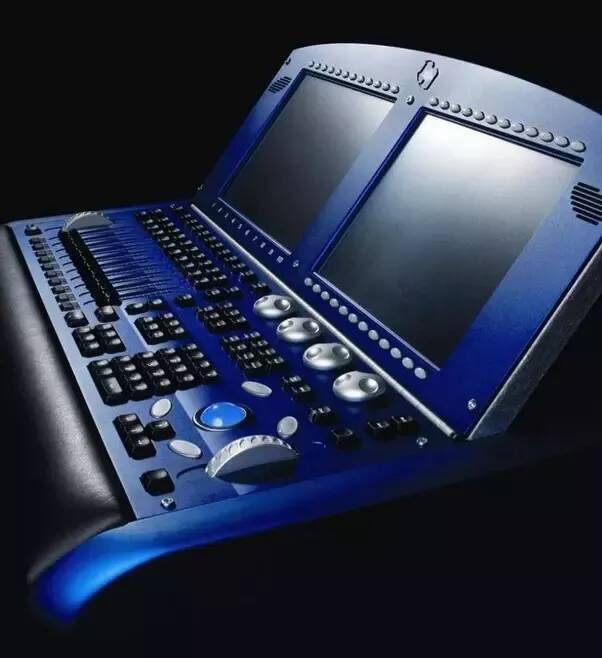
The two screens are touch-screens, for selecting things. Most of the buttons and wheels are “soft” – they can be programmed to do whatever you like, but there are some conventions, for example, the four smaller grey dimpled wheels are often used to control colour wheels for mixing up a colour required. The blue trackball is usually used for positioning a beam’s location on stage, kind of like a mouse pointer, but in real-life – the light beam moves around on stage as you move the trackball. Like a mouse pointer, you can move it fast or slow, and be quite precise.
Almost all lighting control desks (“lighting desk”, or just “desk”) work in a similar way: in the set-up phase of a show, a lighting technician (“programmer”) and a lighting designer work together [2] to create “palettes” of different things – groups of moving lights, colours, gobos, focus’s, positions, etc – commonly used building blocks for the show. As programming goes on, the palettes will be added to and edited. I worked on touring musical theatre shows, so my examples will be based around that, but it’s very similar for any event or show. For a large show, this may take several weeks of programming set-up. For smaller shows, if unlucky, it might be two hours before doors open!
Then, the show “cues” (instructions to the system, that’s triggered at a certain time in the show) can be programmed, from these building blocks. For example, the designer might say, “give me the front wash lights, at full, dark purple, in the downstage line position” – the programmer would simply:
1.Push the “front wash” button to select the fixtures in this group (say, 8 wash lights)
2. Type “@ full” on the keypad for full intensity
(the 8 wash lights in this group would suddenly come on, very bright, pointing straight down in their neutral position, in the colour of white)
3. Push the “dark purple” colour preset – the colour would instantly change to dark purple
4. Push the “downstage line” position button – all the fixtures would instantly pan and tilt to the pre-set position, a line on the downstage (front) edge of the stage
(These commands could be given to the system in any order, but it’d be normal for the programmer to follow the designer’s speech pattern. It’d take less time to make the moving lights do this than it would to say it – the above is five button pushes, and a good moving light programmer touch-types).
Then, the designer would go on to describe other lights’ (usually, groups of lights) position, colour, pattern, etc. Once the designer was happy with the “look” on stage, the cue would be saved, and named (or saved in another palette, if that “look” was often used, reducing five button pushes to one button push in the future). Then, work on the next cue begins – maybe from the previous state (so, only the CHANGES will be recorded), or from scratch, so all the data will be recorded.
The “moving” part of moving lights happens in two ways – a repeating movement could just be one cue – instead of the “downstage line” position, we might use a “position” called “audience circle”, which happens to have a movement sequence recorded in the cue – say, every moving light pointing into the audience, and describing a circle at a certain size and speed. The size of the circle, the speed, and of course the colour and gobo can be set as the designer wishes.
The other main way to do a “move” is to transition from one cue to the next, say, from the “downstage line” position, to the “downstage cross position”, where, instead of pointing straight down, the fixture on the far left points to the far right, and so on. The move between these two cues can be set to occur at any speed (though, the maximum speed, is the speed the lights can move at, which depends on their weight, motor settings, make, and model, and so different fixtures may be specified by the designer for these reasons, as the speed of motion of moving lights is obviously an important factor to how the show looks).
A musical theatre show might have 1,000 cues, each one painstakingly created from the building blocks, over the space of several weeks. A rock concert would tend to have “cue lists”, one for each song (allowing the band to choose a set list at their whim, and drop or add songs for a specific show), and a song may have 10 to 300 cues in it, depending on the style of the show. There might be 20 colours in the colour palette, and 30 positions. At a trade show exhibition stand for cars, 20 moving lights might just rotate through the same three cues all day long (some of them would have a gobo of the car manufacturer’s logo, that roves across the floor of the stand, of course, and maybe out into the aisle a little bit).
When a touring show “loads in” (sets up) in a new venue, the fixtures will be in similar but different positions (and if the cues were executed, they’d look all messed up, because the positions were programmed for a different venue). But, by editing each position “building block” that every cue is based on, selecting each moving light, adjusting its pan and tilt, and overwriting the old settings, executing the cues will become correct immediately (because the colour, gobo, focus, etc does not change when the venue does).
Thus, “touching up” the “position presets” is the bulk of the work on a venue change. The same applies when a fixture breaks and has to be replaced – a new fixture of the same type is hung in the same position, but because a tiny change in the hanging position can be amplified by the throw of the beam, some positions may need to be adjusted.
All this is well and good, lights in the correct position illuminate the subject nicely, but especially for concert stuff (tho for almost all shows of any type these days), a big part of the look is the light beam in the air. Light can only be seen in the air when there’s something in the air for the light to bounce off, into your eyes. We’ve all seen “god’s fingers”, shafts of sunlight before or after a distant storm, where the sun is hitting droplets of water or fog – a similar thing happens in performance spaces, but it’s artificially generated.
The most common method is “haze”, where a light grade oil is “cracked” by forcing tiny bubbles of air through it, it’s “atomised”, and floats through the air. It’s safe, tasteless and odourless, and seldom leaves much of a residue beyond the immediate area of the machine.
Other methods of particle suspension is “fog” (by applying warm water to dry ice, producing a low (one to two feet) thick miasma on stage, or “smoke”, where oils and glycol are mixed and heated, to produce billowing smoke (that often has a noticeable smell/taste, and may come in different flavours like bubblegum does). Smoke may interfere with the voices of performers, but is cheap to make, and effective if it’s appropriately distributed. Smoke tends not to have the “hang time” of haze, so hazers, while expensive, are most often used for most shows.
[1] Only two types of moving lights, moving head and moving mirror… ok, there are some others, but they barely rate a mention. One is a Comear DeSisti NAT, which is a truly weird device, where the head moves, but kinda like a mirror, but the beam can be in more places… but not as much as a moving head light.There some older disco effects which have very basic movement built in (usually, the lamp moves, and the other elements in the fixture are static), and there are oil projectors, where a disc of coloured oil is projected thru. The beam of light heats the oils at different rates, and the effect is projected onto a surface. Very 70’s, and a great mesmerising effect – ideal for a 70’s party, if you can still find a hire shop that has them. [2] The number of people on a lighting crew depends on the size of the show and the budget. Smaller shows, it’s one person does it all (unload the truck, hang all the lights, run the cables, trouble-shoot broken things, design, program and operate the show, and pack it all up at the end – and probably drive the truck to the next venue as well!). On larger shows, there may be dedicated programmers for different types of moving lights, or different parts of the stage, teams of technicians (rigging, repair, etc), and so on. or, anywhere in between.
Shared from Garion Hall, https://www.quora.com/How-do-moving-lights-work.
225x67.png)
305x105-e1479258220185.png)
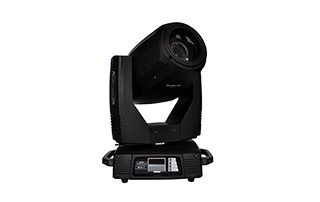
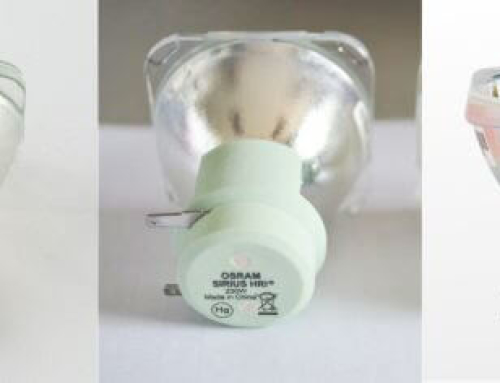
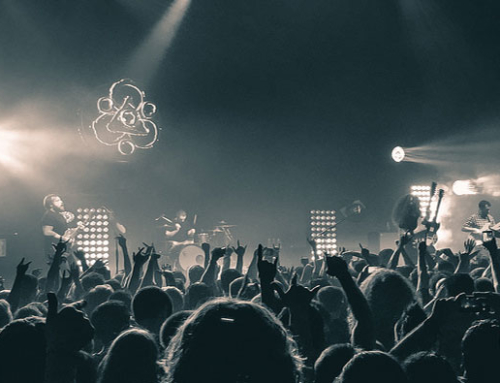


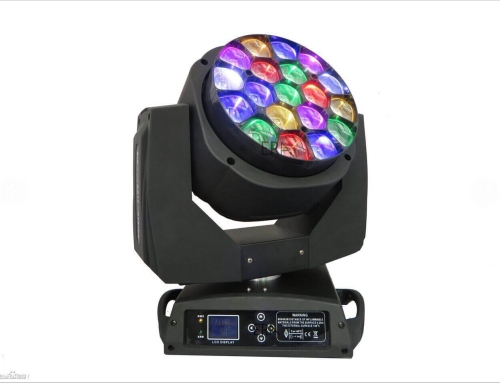
This article and many other on your website are very interesting.
You should show your content to wider audience. There
is a big chance to go viral. You need initial boost and visitors will flood your
site in no time. Just search in google for:
Juuri13 viral effect
Hi Reda,
Thanks your comment on our website.